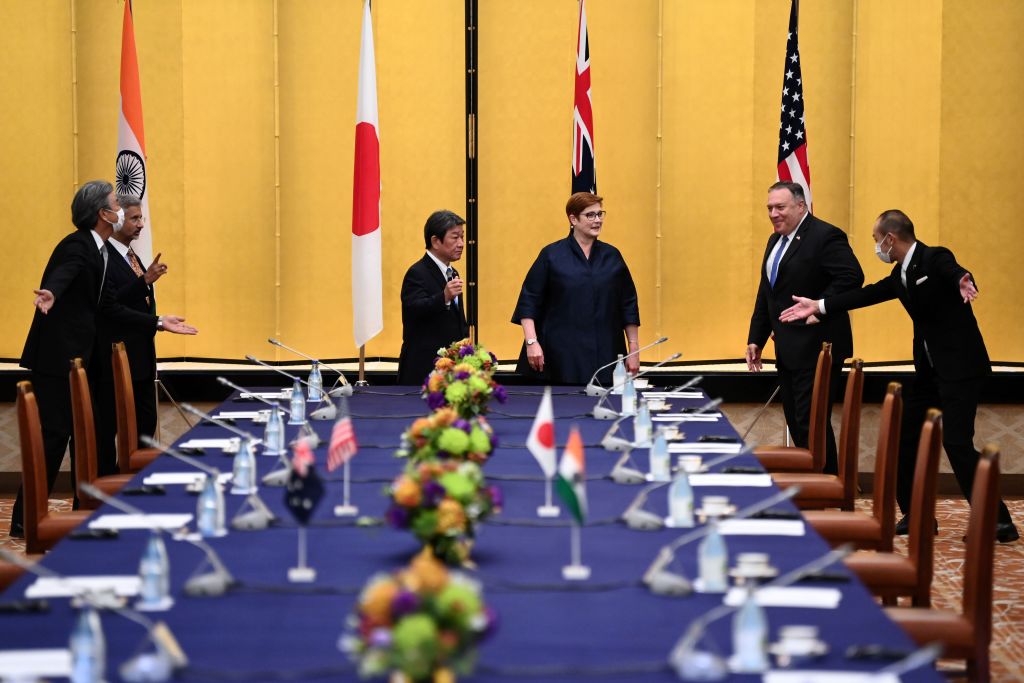
Where Australia’s foreign minister visits tells much about what she and her government value.
Covid-19 means overseas travel for Marise Payne costs 14 days’ quarantine on the return to Oz.
The travel test now comes with an even heftier time impost, underlining the injunction: to weigh what ministers say, watch what they do.
In this year of gloom, doom and Zoom, doing it face to face means the meeting is the message. Then, seek the substance in the statements.
Payne’s two overseas trips in the age of Covid are a statement about what’s important enough to spend a total of 28 days in quarantine.
Her first quarantine-era trip was to Washington in July for the annual AUSMIN meeting.
This month, she headed to Tokyo for the second meeting of the ‘Quad’ foreign ministers of Australia, India, Japan and the United States.
Last year, the foreign ministers did their inaugural four-power pow-wow on the sidelines of the UN General Assembly—as convenient as it was symbolic. This year’s journey to Tokyo—a much less convenient pow-wow—amped up the message of the meeting.
On her way home from Tokyo, Payne visited Singapore.
The travel-importance equation thus reads: the US alliance, the Quad and ASEAN. If Payne makes a third Covid-era trip this year (for a total of six weeks in quarantine), Southeast Asia is the likely choice, to emphasise the ASEAN dimension.
The message from the meetings is Australia expressing what it values and facing what it fears. Principles and push-back join. The context is how power is balancing (or not) in the Indo-Pacific.
The dragon in the room for every meeting is China. Beijing’s behaviour injects a lot of darkness into the Indo-Pacific conversation.
The AUSMIN communiqué called out China over the erosion of Hong Kong’s autonomy, the repression of Uyghurs, coercive and destabilising actions in the South China Sea, and the need for good faith in negotiating limits on nuclear weapons.
Even when it’s not named, China gets lots of other attention, from cyber to Covid-19.
A new area of public push-back from Payne’s Washington trip was over Taiwan. In the previous decade, the annual AUSMIN communiqués never once mentioned Taiwan. (To read through a decade’s worth of communiqués is to track the fall from business-as-usual comfort to the discomfort of today’s wobbly Indo-Pacific).
From being a taboo topic, this year Taiwan got significant AUSMIN wordage and a warm embrace.
See what Australia has signed up to. We have ‘re-affirmed Taiwan’s important role in the Indo-Pacific region’. We intend to ‘maintain strong unofficial ties’. We will support Taiwan’s role in international organisations as either a full member or an observer. The push-back against China’s threats and coercion was this line: ‘The United States and Australia highlighted that recent events only strengthened their resolve to support Taiwan.’ Plus, Australia promises more aid coordination with Taiwan in the South Pacific.
Much of what Australia previously did silently with Taiwan we now proclaim. Push-back is translating into public pokes at Beijing. Taiwan is the most sensitive poke point of all, along with the power and personality of Xi Jinping.
The message out of the Quad reads: We like-minded democracies have much we can do together. We have a clear and strong interest in giving confidence to others worried about China (hi, ASEAN). The Quad demonstrates that the Indo-Pacific does have options. The future doesn’t have to be determined and dominated by China.
India is the most cautious member of the Quad, but China has done to India what it’s done to Australia—sharpened and clarified the choices. China is the godfather of Quad 2.0 just as much for India as it is for Australia.
Payne’s Quad message is crisp. Lots of China content without using the C-word. Because there’s no Quad communiqué, each foreign minister gives their own summation. Payne delivers six paragraphs that are a tight survey of the Indo-Pacific.
Australia’s foreign minister starts with Covid-19, then turns to the Indo-Pacific’s shaky strategic environment: ‘Pressure on the rules, norms and institutions that underpin stability has the potential to undermine recovery.’
Looking at but not mentioning China, she notes it’s ‘vital that states work to ease tensions and avoid exacerbating long-standing disputes, work to counter disinformation, and refrain from malicious cyberspace activity’. And she repeats the lengthier AUSMIN thought that ‘states cannot assert maritime claims that are inconsistent with international law’.
Payne’s Quad statement hugs ASEAN centrality and the important principles of the ASEAN outlook statement on the Indo-Pacific.
On the purpose of the Quad, Payne offers liberal values and balance-of-power competition in the same sentence: ‘We agreed to enhance cooperation to promote a strategic balance in the Indo-Pacific, and work to support a region of resilient and sovereign states that engage each other on the basis of rules, norms and international law.’
What once would have been motherhood truism about rules and norms is today a call to action.
The value of rules and agreement will get another workout next month with the unveiling of the most important regional trade agreement ever signed, the Regional Comprehensive Economic Partnership.
China and ASEAN will be on stage beaming; Australia will be equally sunny, standing with fellow RCEPers Japan, South Korea and New Zealand. The gap on the stage will be India, while the US is the ghost at the feast.
The irony of the shiny free-trade moment is that RCEP arrives as China tightens its coercive campaign against Australia, now targeting the coal and cotton industries. Australia does push-back. China does punishment.
To put punch in Oz push-back, Marise Payne’s travels embrace the alliance, the Quad and ASEAN. To deal with China, Australia looks beyond Beijing to join with others. The message of the meetings is to build substance with the symbolism.

